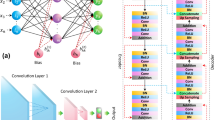Abstract
In free-form surface reconstruction technology, the ultimate goal is to obtain a computer model of a free-form surface. This study discusses the inpainting method of arbitrary surface data based on geometric convolutional neural networks. Reverse engineering is a process of product design technology reproduction, that is, reverse analysis and research of a target product, to deduce and obtain design elements such as the processing flow, organizational structure, functional characteristics and technical specifications of the product to produce functional similar but not identical products. This paper realizes the noise point elimination of point cloud data by studying reconstruction technology of free-form surfaces using a geometric convolutional neural network model. Point cloud data without gross errors are provided for later reconstruction. High-precision arbitrary surface data are realized for surface reconstruction. The repair of arbitrary surface data is completed based on BP and RBF neural networks, and a certain degree of data supplementing for the incomplete point cloud data measured is realized. Finally, free-form surface reconstruction is realized. In reverse engineering, a flexible surface is converted into a rigid surface, and the data points are collected using contact measuring equipment. The influencing factors of reverse engineering are work efficiency, technical ability and the influencing factors of innovative design. The data points obtained in this study are processed by denoising, streamlining and filtering. The sorted data points are used to obtain an optimized mathematical model after curve and surface fitting and smoothing. The research in this study proves that the data points obtained using the reverse engineering method can be very well applied in subsequent work. Therefore, this data collection method can be applied to other instances. In the experiment, the maximum error between the output of the RBF network and the test data is 0.0086 when surface 2 is repaired. When the hybrid learning algorithm is trained with different sample sets, the average width is 0.24, and the number of iterations is 1000. The experimental results of repairing various surface defect data show that the data repairing method has good versatility, fast data repairing speed and high precision, so it has high practical value.









Similar content being viewed by others
References
Chen YH, Krishna T, Emer JS (2017) Eyeriss: an energy-efficient reconfigurable accelerator for deep convolutional neural networks. IEEE J Solid-State Circuits 52(1):127–138
Segler M, Kogej T, Tyrchan C (2018) Generating focused molecule libraries for drug discovery with recurrent neural networks. ACS Cent Sci 4(1):120–131
Goh ATC (2017) Seismic liquefaction potential assessed by neural networks. Environ Earth Sci 76(9):1467–1480
Chen X, Xiang S, Liu C (2017) Vehicle detection in satellite images by hybrid deep convolutional neural networks. IEEE Geosci Remote Sens Lett 11(10):1797–1801
Cakir E, Parascandolo G, Heittola T (2017) Convolutional recurrent neural networks for polyphonic sound event detection. IEEE/ACM Trans Audio Speech Lang Process 25(6):1291–1303
Perna C, Rocca ML (2017) Designing neural networks for modeling biological data: a statistical perspective. Math Biosci Eng MBE 11(2):331–342
Schirrmeister RT, Gemein L, Eggensperger K (2017) Deep learning with convolutional neural networks for decoding and visualization of EEG pathology. Hum Brain Mapp 38(11):5391–5420
Zhang CK, He Y, Jiang L (2017) Delay-dependent stability criteria for generalized neural networks with two delay components. IEEE Trans Neural Netw Learn Syst 25(7):1263–1276
Liu M, Shi J, Zhen L (2017) Towards better analysis of deep convolutional neural networks. IEEE Trans Vis Comput Gr 23(1):91–100
Yang C, Wang X, Li Z (2017) Teleoperation control based on combination of wave variable and neural networks. IEEE Trans Syst Man Cybern Syst 47(8):2125–2136
Wu A, Zeng Z (2017) Lagrange stability of memristive neural networks with discrete and distributed delays. IEEE Trans Neural Netw Learn Syst 25(4):690–703
Subramanian V, Hung MS (2017) A GRG2-based system for training neural networks: design and computational experience. Inf J Comput 5(4):386–394
Ahn CK, Shi P, Wu L (2017) Receding horizon stabilization and disturbance attenuation for neural networks with time-varying delay. IEEE Trans Cybern 45(12):2680–2692
Wang JL, Wu HN (2017) Synchronization and adaptive control of an array of linearly coupled reaction-diffusion neural networks with hybrid coupling. IEEE Trans Cybern 44(8):1350–1361
Wang Z, Joshi S, Savel’Ev S (2018) Fully memristive neural networks for pattern classification with unsupervised learning. Nat Electron 1(2):137–145
Funding
This work is supported by Natural Science Foundation of Fujian Province, China (2022J02050) Special Fund granted by Minjiang University, NSFC (No. 11801078) granted by National Natural Science Foundation of China Fujian Provincial Natural Science Fund (No. 2018J05001) granted by Fujian Natural Science and Technology Ministry.
Author information
Authors and Affiliations
Corresponding authors
Ethics declarations
Conflict of interest
The authors declare that there is no conflict of interest with any financial organizations regarding the material reported in this manuscript.
Additional information
Publisher's Note
Springer Nature remains neutral with regard to jurisdictional claims in published maps and institutional affiliations.
Rights and permissions
Springer Nature or its licensor holds exclusive rights to this article under a publishing agreement with the author(s) or other rightsholder(s); author self-archiving of the accepted manuscript version of this article is solely governed by the terms of such publishing agreement and applicable law.
About this article
Cite this article
Fan, L., Ji, D. & Lin, P. Arbitrary surface data patching method based on geometric convolutional neural network. Neural Comput & Applic 35, 8763–8774 (2023). https://doi.org/10.1007/s00521-022-07759-4
Received:
Accepted:
Published:
Issue Date:
DOI: https://doi.org/10.1007/s00521-022-07759-4




